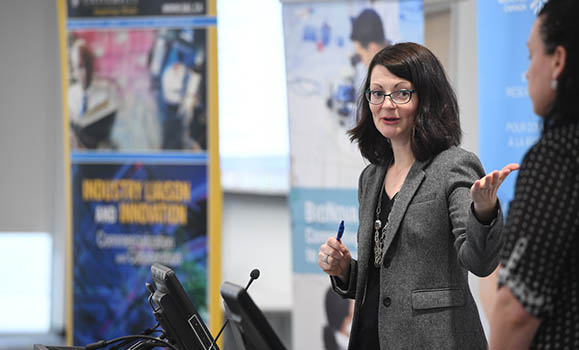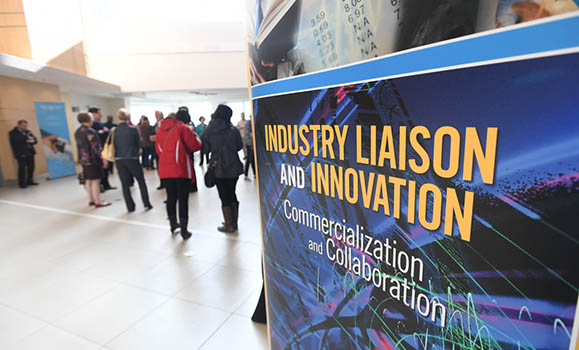Developing a new drug and getting it into clinics can take up to 12 years ‚ÄĒ and without the right partnerships early on, many promising ideas fail to even get off the ground.
A drug development boot camp hosted by H¬ĢĽ≠ this week offered both researchers and pharmaceutical industry reps a chance to come together under one roof to sharpen their skills and improve their chances of building successful partnerships across academic and industry boundaries.
The intensive two-day educational event was the brainchild of Doris Grant and Andrea McCormick of Dal's (ILI) office, a team that helps facilitate the commercialization of research at the university.
"You need good science, but partnerships are all about people," said Doris Grant (below), associate director of life and health sciences at ILI. "Putting people together and giving them the opportunity to speak and spend some time together goes a long way to establishing a successful partnership."

H¬ĢĽ≠ 40 academics ‚ÄĒ including researchers, post-docs and grad students from Dal and Cape Breton University ‚ÄĒ participated in the event along with members from Innovative Medicines Canada, an industry association for the national pharmaceutical industry that partnered with the ILI and other groups on the event including H¬ĢĽ≠ Medical Research Foundation, Springboard Atlantic, BioNova and the H¬ĢĽ≠ Faculty of Medicine.
The conference included lectures, hands-on simulations and one-on-one consultations with industry veterans on everything from the language and skills needed to engage the interest of industry and large biotech companies to understanding the processes that can increase the likelihood of establishing funding partnerships.
Learning from industry insiders
Pharmaceutical industry experts were brought in to help facilitate some of the activities, which included a role-playing simulation where teams learned what it’s like to be an academic entering into an industry culture.
"They're learning how to create data in their labs and identify resources for creating that data to interest partners in the development of medicines ‚ÄĒ how to translate their basic bench-top research into biotech industry products," said Dr. Chari Smith, one of the three consultants brought in for the event. (The other two were Fernando Alberdi, a Michigan-based lawyer with Honigman, and Brad Henke, who runs Opti-Mol Consulting in Raleigh, North Carolina.)
Dr. Smith ‚ÄĒ a 25-year veteran of British pharma giant GlaxoSmithKline (GSK) and drug development consultant at Princeton University ‚ÄĒ said while some partnerships are built on relatively straightforward licensing deals, others require more complex collaborations from conception of a topic through to choosing a clinical candidate for a product.
Ownership of intellectual property, freedom to publish information and the negotiation of milestones and financials are just a few of the challenges that arise when these two overlapping, yet distinct, cultures come face to face, said Dr. Smith.
‚ÄúThe clash of cultures always has to be overcome for every decision,‚ÄĚ she said.
Gordon Simms, a post-doctoral fellow in Pharmacology at Dal, said participating in the boot camp gave him a chance to explore a side of science that he doesn’t get to see in practice every day.
‚ÄúThere are a lot of perspectives in drug design, so it‚Äôs nice to get a good sense of all those perspectives because it‚Äôs really easy to fall into your own little bubble of your experience and your knowledge,‚ÄĚ said Dr. Simms, who graduated with a PhD in Medicinal Chemistry from Dal last year.

Dr. Simms, who is also a team leader with a Dal spinout company tentatively called NovaSight that is developing a therapeutic drug to treat a rare form of childhood blindness, said the conference further hammered home for him just how important it is to have intellectual property on discoveries.
‚ÄúIf you don‚Äôt have intellectual property on something, it‚Äôs never going to move forward,‚ÄĚ he said. ‚ÄúYou want to make sure the science is right, but you want to make sure you can actually market it and recoup your costs, especially if you‚Äôre spending millions on research programs.‚ÄĚ
Making connections
ILI’s Grant said the conference also presented an opportunity for Dal to connect more closely with national industry reps for the big pharma companies, seven of whom were represented at the event. She said national reps often serve as a conduit to the global reps and that bringing some of them to Dal was a way to help them better understand some of the work being done here.
McCormick said ILI hopes to offer the boot camp annually and that she was pleased to see such a good turnout this year.
Őż
‚ÄúIt‚Äôs really about using the right language and better understanding pharma‚Äôs processes,‚ÄĚ she says, ‚Äúso that researchers know how to better position their projects for future collaborations.‚ÄĚ

